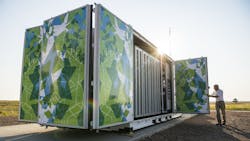Battery Research Tackles New Challenges for Behind-the-Meter Stationary Storage Systems
The national transition to net-zero carbon emissions by 2050 will demand more from our electric grid than ever before. Stationary energy storage systems are critical to grid resiliency by ensuring that the power from renewable energy sources is available when and where it is needed.
Energy efficient buildings of the future are turning to holistic behind-the-meter storage (BTMS) system designs to minimize costs and grid impacts due to their ability to integrate electric vehicle charging, photovoltaic generation, and building demands using controllable loads to generate and store energy on-site.
As part of the U.S. Department of Energy’s BTMS Consortium, researchers at the National Renewable Energy Laboratory (NREL) are leading the development of new lithium-ion (Li-ion) battery designs specific to the stationary storage requirements.
“We already know a lot about Lithium-ion batteries, but batteries for different applications have different requirements,” said Yeyoung Ha, researcher and project leader, NREL . “Our research looks at how to leverage the developments from electric vehicle battery research for new applications in stationary storage.”
BTMS systems have different charging and discharging patterns than a typical electric vehicle and require Li-ion battery materials that meet these unique priorities. Li-ion battery designs using a Li4Ti5O12 (LTO) anode and LiMn2O4 (LMO) cathode are promising critical-material-free candidates that offer the safety and long lifespan required of BTMS systems. While these cells in conventional design have a comparatively low energy density, new research at NREL, published in the Journal of the Electrochemical Society, delved further into promising opportunities, as well as limitations, of using LTO/LMO battery cells for stationary storage use.
This project evaluated the temperature-dependent performance of LTO/LMO cells with various electrode loadings. Researchers determined that using thicker electrodes in battery designs can increase the cell capacity and energy density, while decreasing overall cell costs. However, these thicker electrodes require ions to travel a longer path, limiting the utilization of electrodes. Temperature adjustments can alleviate these negative impacts but may introduce added complications. The trick is to design a battery that offers the best balance for stationary applications.
“Our goal with this research is to identify a ‘sweet spot’ to leverage the advantages of electrode loading and increased temperatures to maximize the performance of LTO/LMO battery cells,” Ha said. “Our research refined material designs for BTMS specifically, converting this well-known power chemistry to energy cells.”
The NREL team further verified their findings by applying electrochemical modeling to simulate reactions at different temperatures and electrode thickness. This modeling, in alignment with experimental results, emphasized the impact of transport limitations and informed strategies to improve the cell performance. By allowing batteries to have intermittent rest during discharge, instead of being fully discharged as for electric vehicles, the electrode utilization was significantly improved. Researchers found this type of pulsed discharge is well suited for BTMS stationary applications, where the batteries will be used only when there is intermittent demand and then transitioned back to a resting stage.
Although these optimized LTO/LMO battery cells offer many advantages, the research team is also exploring cathode options that may better meet BTMS system needs. NREL’s expertise in materials development will be combined with the cutting-edge electrochemical modeling used in this project to streamline further research into new materials and experimental battery designs for stationary storage and beyond.
Learn more about NREL’s energy storage research and sustainable transportation and mobility research.
About the Author
T&D World Staff
Content Team
Nikki Chandler
Group Editorial Director, Energy
[email protected]
Jeff Postelwait
Managing Editor
[email protected]
Christina Marsh
Senior Editor
[email protected]
Ryan Baker
Associate Editor
[email protected]
Amy Fischbach
Electric Utility Operations
[email protected]
Rich Maxwell
Community Editor
[email protected]
Gene Wolf
Technical Editor
[email protected]
